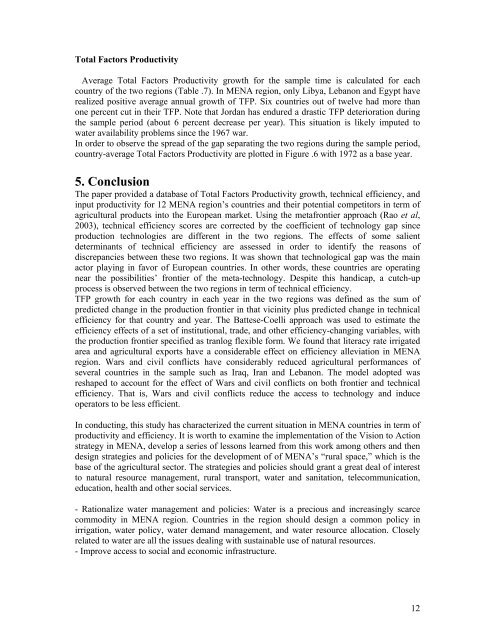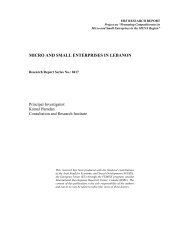Agricultural Productivity and technological gap between MENA ...
Agricultural Productivity and technological gap between MENA ...
Agricultural Productivity and technological gap between MENA ...
Create successful ePaper yourself
Turn your PDF publications into a flip-book with our unique Google optimized e-Paper software.
Total Factors <strong>Productivity</strong>Average Total Factors <strong>Productivity</strong> growth for the sample time is calculated for eachcountry of the two regions (Table .7). In <strong>MENA</strong> region, only Libya, Lebanon <strong>and</strong> Egypt haverealized positive average annual growth of TFP. Six countries out of twelve had more thanone percent cut in their TFP. Note that Jordan has endured a drastic TFP deterioration duringthe sample period (about 6 percent decrease per year). This situation is likely imputed towater availability problems since the 1967 war.In order to observe the spread of the <strong>gap</strong> separating the two regions during the sample period,country-average Total Factors <strong>Productivity</strong> are plotted in Figure .6 with 1972 as a base year.5. ConclusionThe paper provided a database of Total Factors <strong>Productivity</strong> growth, technical efficiency, <strong>and</strong>input productivity for 12 <strong>MENA</strong> region’s countries <strong>and</strong> their potential competitors in term ofagricultural products into the European market. Using the metafrontier approach (Rao et al,2003), technical efficiency scores are corrected by the coefficient of technology <strong>gap</strong> sinceproduction technologies are different in the two regions. The effects of some salientdeterminants of technical efficiency are assessed in order to identify the reasons ofdiscrepancies <strong>between</strong> these two regions. It was shown that <strong>technological</strong> <strong>gap</strong> was the mainactor playing in favor of European countries. In other words, these countries are operatingnear the possibilities’ frontier of the meta-technology. Despite this h<strong>and</strong>icap, a cutch-upprocess is observed <strong>between</strong> the two regions in term of technical efficiency.TFP growth for each country in each year in the two regions was defined as the sum ofpredicted change in the production frontier in that vicinity plus predicted change in technicalefficiency for that country <strong>and</strong> year. The Battese-Coelli approach was used to estimate theefficiency effects of a set of institutional, trade, <strong>and</strong> other efficiency-changing variables, withthe production frontier specified as tranlog flexible form. We found that literacy rate irrigatedarea <strong>and</strong> agricultural exports have a considerable effect on efficiency alleviation in <strong>MENA</strong>region. Wars <strong>and</strong> civil conflicts have considerably reduced agricultural performances ofseveral countries in the sample such as Iraq, Iran <strong>and</strong> Lebanon. The model adopted wasreshaped to account for the effect of Wars <strong>and</strong> civil conflicts on both frontier <strong>and</strong> technicalefficiency. That is, Wars <strong>and</strong> civil conflicts reduce the access to technology <strong>and</strong> induceoperators to be less efficient.In conducting, this study has characterized the current situation in <strong>MENA</strong> countries in term ofproductivity <strong>and</strong> efficiency. It is worth to examine the implementation of the Vision to Actionstrategy in <strong>MENA</strong>, develop a series of lessons learned from this work among others <strong>and</strong> thendesign strategies <strong>and</strong> policies for the development of of <strong>MENA</strong>’s “rural space,” which is thebase of the agricultural sector. The strategies <strong>and</strong> policies should grant a great deal of interestto natural resource management, rural transport, water <strong>and</strong> sanitation, telecommunication,education, health <strong>and</strong> other social services.- Rationalize water management <strong>and</strong> policies: Water is a precious <strong>and</strong> increasingly scarcecommodity in <strong>MENA</strong> region. Countries in the region should design a common policy inirrigation, water policy, water dem<strong>and</strong> management, <strong>and</strong> water resource allocation. Closelyrelated to water are all the issues dealing with sustainable use of natural resources.- Improve access to social <strong>and</strong> economic infrastructure.12
















